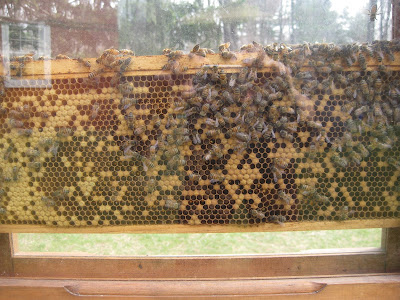The honeybee is the only insect that produces a food that humans eat. But more important than producing honey is its role in agriculture. The pollination of fruit trees, seed crops and greenhouse plants would not be possible without the honeybee.
 |
| This is an observation hive. Live bees can come to your classroom in complete safety! |
 |
| With a magnifying lens, you can see the larva in the cells. Why are the cells hexagonal in shape? Did you know that bees are great mathematicians? |
 |
| This is a Langstroth long hive. It's easier to observe the development of brood in a hive like this. |
On our farm in Easton, we have traditional hive bodies set up on cinder blocks.
Protective clothing is important!
If you can't make it to the farm, a hive body filled with frames with images of bee activity can come to your classroom!
This frame shows brood hatching.
This frame shows a queen cell.
There are also bees in plastic resin, for those classrooms that prefer not to have live bees.

Want to learn a bee dance?
What is special about beeswax?
How do worker bees know what chores to do in the hive?
Presentations can be tailored to your interest and age group.















No comments:
Post a Comment